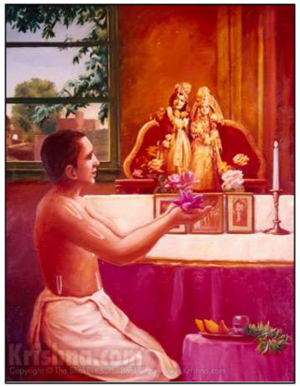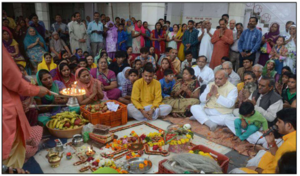Talk:Archanāṃ or Pūjā
By Vishal Agarwal
This means performing a ceremony to worship Bhagavān using simple articles like a lamp, bell, flowers, fruit, water, coconut, etc., while chanting prayers. As opposed to the expensive ingredients required for the Vedic yajña, arcanā is a very simple and inexpensive affair and therefore accessible to all.
One of the ways of worshipping Bhagavān is doing ārati by waving before the mūrti a whisk, flowers, light, cloth, and water. These represent offering the five gross elements:
- Air – symbolized by the whisk
- Earth – represented by flowers, the most beautiful product of earth
- Fire – represented by the lamp
- Space – represented by cloth (woven with gaps)
- Water – directly offered
The purpose of waving them before a mūrti symbolizes the fact that He alone is the Lord of this entire universe, and all that we have is offered in His service.[1]
Pūjā is done to invoke the devatā-s to protect us and fulfill our worldly and spiritual needs. Some salient features of this form of bhakti are:
- Pūjā makes us sensitive and aware that not everything is in our control.
- It can be in the form of focusing the mind on the iṣṭa-devatā.
- Typically performed in front of an image or mūrti of the devatā.
- The traditional method involves 5, 16, or 64 upacāra-s (steps), but it can also be done simply with available offerings.
- Pūjā can be performed at home, in a temple (maṇḍira), or even anywhere as needed. Daily pūjā transforms a house into a maṇḍira.
- It can be done individually or in a group.
- One should try to do at least one pūjā every day, whether alone or collectively.
- The physical nature of the ceremony — involving speech, mind, and bodily action — is beneficial for those who need external aids to focus mentally on the Lord.
References[edit]
- ↑ Swami Nirvedananda. Hinduism at a Glance. Ramakrishna Mission, 1996, pp. 210–211, Kolkata.


